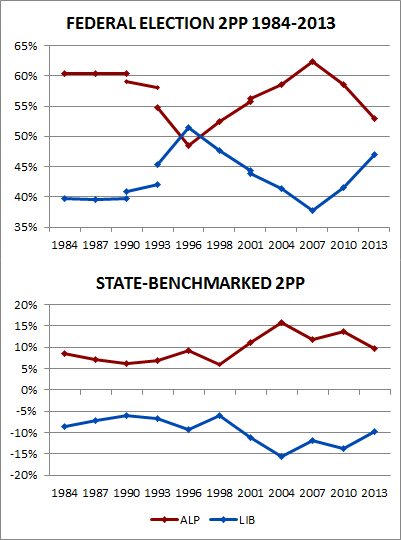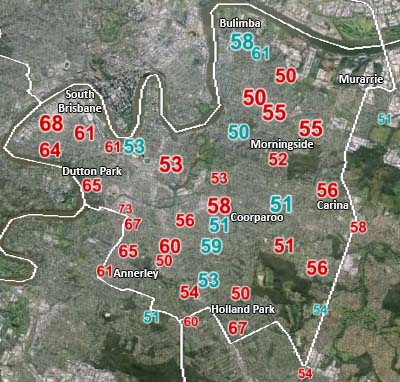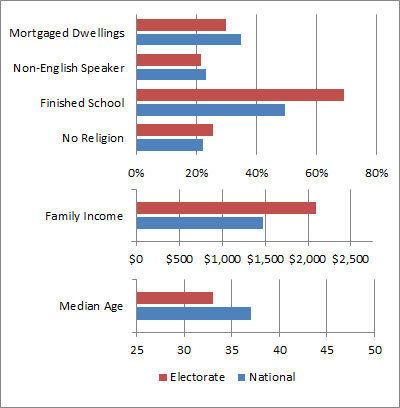Friday, February 7
Interesting to observe a run on Bill Glasson in the betting markets, following reports showing Labor internal polling had him on 47% of the primary vote. After being at $6.25 a few days ago, a Glasson victory will now only get you $3.75, with Labor’s Terri Butler out from $1.10 to $1.25. However, Labor sources now tell Troy Bramston of The Australian they have pulled ahead in their most recent polling, with Glasson down to 44% and Butler with 42% of the primary vote and 53% of two-party preferred. At the same time, Andrew Fraser of The Australian relates Labor concerns that voters are “suffering extreme electoral fatigue and may stay at home”. On the other side of the equation, Joanna Heath of the Financial Review reports Liberals have “all but given up hope”. I find myself believing the Liberals on this occasion, and will be requiring rather more than $3.75 before I take a punt on them.
Wednesday, February 5
With the campaign in its final week, Labor seems keen to dispel the notion that it has the matter in hand to the extent that Centrebet should be offering $1.10 on their candidate Terri Butler, against $6.25 for the LNP’s Bill Glasson. Among others, Dennis Atkins of the Courier-Mail has spoken of Labor internal polling conducted early last month showing Bill Glasson’s vote up to a formidable 47% from the 42% he recorded at the election. Phillip Coorey of the Financial Review puts considerably more meat on the bones of Labor polling talk, offering personal ratings for the two candidates, the party leaders and Campbell Newman. These indicate that both Glasson and Butler are viewed very favourably, but with Glasson quite a bit better known, scoring an “unsure” rating of 18% compared with Butler’s 40%. Bill Shorten is viewed neutrally, which he might be pleased with given this is Kevin Rudd’s turf. Both the Coalition leaders are viewed unfavourably, Campbell Newman especially. However, the numbers do not encompass voting intention, a Labor source merely offering that “the primary vote for Dr Glasson continues to be in the high 40’s”. This is said to be very much a “personal vote” for Glasson, who told attendees at his campaign launch on Sunday that voters should be concerned only with “selecting the next member for Griffith”. This came as news to Julie Bishop, who several times during her speech said they would be doing so for the seat of Griffin.
Friday, January 17
With the closure of nominations yesterday, 11 candidates have emerged, with Bill Glasson copping last place on the ballot paper. In order: Timothy Lawrence (Stable Population Party); Geoff Ebbs (Greens); Christopher David Williams (Family First); Karel Boele (Independent); Anthony Ackroyd (Bullet Train for Australia); Anne Reid (Secular Party); Terri Butler (Labor); Melanie Rose Thomas (Pirate Party); Travis James Windsor (Independent); Ray Sawyer (Katter’s Australian Party); Bill Glasson (Liberal National Party).
Tuesday, January 7
The Speaker of the House of Representatives, Bronwyn Bishop, yesterday set February 8 as the date for the by-election, hence my bumping of this post to the top of the blog. Nominations close on Thursday, January 16, with the ballot paper draw to be held the following day. As foreshadowed in the previous entry, Labor’s candidate will be Terri Butler, to face Bill Glasson of the LNP and Geoff Ebbs of the Greens. Clive Palmer has announced that the Palmer United Party will not be fielding a candidate, preferring instead to focus its energies on the anticipated Western Australian Senate re-match. Here’s how I reviewed the situation in an overview of the electoral year ahead for today’s Crikey:
The first of these is the byelection to choose a successor to Kevin Rudd in his inner-southern Brisbane seat of Griffith, which was yesterday set for February 8 by Bronwyn Bishop in her capacity as Speaker. It’s been a mere eight weeks since Rudd’s surprise resignation placed this particular item on the agenda, but that’s been more than enough time to require that the original conventional wisdom about the contest be cast aside.
Although Griffith’s inner-city orientation makes it one of Labor’s most reliable seats in Queensland, the party has known it to be loseable since Rudd himself failed to carry it on his first attempt in 1996. The circumstances of the byelection also granted the Liberal National Party something of a head start.
Labor’s administration had no advance warning of Rudd’s intentions, whereas the LNP found itself ready to go with the candidate it had optimistically recruited to take the fight to Rudd in September, former Australian Medical Association president Bill Glasson. That was certainly how betting markets initially read the situation, with Sportsbet making an opening offer of $1.75 on Glasson against $2.10 for a then-unnamed Labor candidate, who has turned out to be Maurice Blackburn lawyer Terri Butler.
It also seemed safe to assume that the deck would contain a wild card in the shape of the Palmer United Party, fresh from polling over 11% in Queensland at the federal election and facing the apparently golden opportunity of an electorate primed for a protest vote by the inconvenience of a byelection.
Both those bets are now off, almost literally in the first instance — coincidentally or otherwise, Kevin Rudd’s resignation coincided precisely with the Abbott government’s end-of-year dive in the polls, which has been accompanied by a blowout in Sportsbet’s price on Glasson to $4. Clive Palmer has also surprised by staying out of the fray, arguing his considerable resources can be better marshalled elsewhere.
Thursday, November 27
Tony Moore of Fairfax reports that February 1 is looming as the likely date of both the Griffith federal and Redcliffe state by-elections. Bill Glasson has confirmed he will run as the Liberal National Party candidate, while two candidates have emerged for a Labor preselection to be held on December 14, with Virgin Blue pilot Jeremy de Lore putting his name forward together with Maurice Blackburn lawyer Terri Butler, who appears to have the nomination sewn up. Sportsbet’s market for the seat has moved heavily towards Labor over the past fortnight: a Labor win is now paying $1.50 after starting at $2.10, while the LNP is out from $1.75 to $2.50.
Sunday, November 17
Bill Glasson has confirmed his intention to stand as the Liberal National Party candidate. However, two of the Labor front-runners identified in the post below – Di Farmer and Shayne Sutton – have both announced they will not contest the Labor preselection, for which nominations open tomorrow. Farmer had been rated particularly highly as a preselection prospect, but has cited family reasons for her decision not to put her name forward. The remaining Labor contender out of the three is Terri Butler, an industrial relations lawyer and member of the Left. Dennis Atkins of the Courier-Mail said on Insiders this morning that the Right was “scrambling around” for a new candidate in place of Farmer. A local operating under the handle of @GriffithElects is helpfully following events as they unfold Twitter.
Sportsbet has a market open on the by-election, rating the LNP favourites at $1.75 with $2.10 for Labor, $9 for the Palmer United Party and $34 for the Greens.
Thursday, November 14
Kevin Rudd’s announcement that he will resign from parliament at the end of the week provides the occasion for a) renewed debate about his political legacy, which I will leave to others to pursue (in some cases for the rest of your lives), and b) the breaking of the longest federal by-election drought since 1951. The looming contest for Rudd’s inner southern Brisbane seat of Griffith will be the first by-election in over four years, and almost certainly the first contested by both major parties in nearly six. Labor will be fighting to defend a margin of just 3.0%, following a 5.5% swing to the Liberal National Party on September 7. Antony Green calculates that the earliest possible date for the by-election is December 21, but with a date that close to Christmas out of the question, and school holidays generally being off limits, it is unlikely to be held any earlier than February.
The Australian reports that three names are being mentioned as potential Labor candidates: Di Farmer, who held the locally corresponding state seat of Bulimba until she joined Labor’s massive casualty list at the election of March last year; Terri Butler, a lawyer with Maurice Blackburn; and Shayne Sutton, a former Rudd staffer who serves Morningside ward on Brisbane City Council, on which she once led the Labor opposition. The Australian speaks of “growing support among the branches for Ms Farmer”, but Fairfax reports something similar of Butler, whose alignment with the Left would appear to stand her in particularly good stead in the green-left area around South Brisbane and West End. The Fairfax report says the trump card for Farmer, a member of the Right, is that she is likely to have the support of Rudd. Sutton on the other hand might be dissuaded by the need to abandon her seat on council in order to run, which would involve sacrificing a position worth nearly $150,000 a year for the sake of an uncertain electoral prospect.
 As for the Liberal National Party, it is generally expected that their candidate at the recent election, Bill Glasson, will again take the field. Glasson is an ophthalmologist and former Australian Medical Association president whose father, Bill Glasson Sr, was a state National Party MP and minister in the Bjelke-Petersen, Ahern and Cooper governments. Bernard Keane of Crikey is among those who like his chances, presumably on the basis that Labor will be hit hard by the loss of Rudd’s personal vote. This point is well illustrated by charts displayed to the right, which track the two-party vote in the electorate going back to 1984. The bottom chart shows the difference between Griffith and Queensland state results with adjustments made to cancel out the effects of redistributions. This suggests either that some manner of demographic shift happened to coincide with Rudd’s tenure as member commencing in 1998, or that he personally was responsible for a solid improvement in Labor’s vote – albeit that the effect wore off somewhat at the most recent election (on which basis I might hypothesise that Rudd, like John Howard before him, suffered from a perception that he would shortly be gone from parliament in any case). Further evidence of a strong personal vote for Rudd was provided by the result of the 2004 election, when a large area of Griffith was carved off to create the new seat of Bonner. The affected areas swung heavily to the Liberals in Rudd’s absence, contributing to a surprise Labor defeat in the new seat.
As for the Liberal National Party, it is generally expected that their candidate at the recent election, Bill Glasson, will again take the field. Glasson is an ophthalmologist and former Australian Medical Association president whose father, Bill Glasson Sr, was a state National Party MP and minister in the Bjelke-Petersen, Ahern and Cooper governments. Bernard Keane of Crikey is among those who like his chances, presumably on the basis that Labor will be hit hard by the loss of Rudd’s personal vote. This point is well illustrated by charts displayed to the right, which track the two-party vote in the electorate going back to 1984. The bottom chart shows the difference between Griffith and Queensland state results with adjustments made to cancel out the effects of redistributions. This suggests either that some manner of demographic shift happened to coincide with Rudd’s tenure as member commencing in 1998, or that he personally was responsible for a solid improvement in Labor’s vote – albeit that the effect wore off somewhat at the most recent election (on which basis I might hypothesise that Rudd, like John Howard before him, suffered from a perception that he would shortly be gone from parliament in any case). Further evidence of a strong personal vote for Rudd was provided by the result of the 2004 election, when a large area of Griffith was carved off to create the new seat of Bonner. The affected areas swung heavily to the Liberals in Rudd’s absence, contributing to a surprise Labor defeat in the new seat.
Nonetheless, swings to governments at federal by-elections are exceedingly rare, even for newly elected governments in the apparent bloom of their honeymoon. The first by-election held after the election of the Rudd government was in Gippsland in June 2008, following the resignation of Nationals member and Howard government minister Peter McGauran. Labor’s two-party preferred vote as measured by opinion polls of the time was tracking in the high fifties, but they nonetheless emerged on the wrong end of a 6.1% swing despite having devoted considerable energy to their campaign. An ascendant Hawke government was similarly disappointed when it failed to poach Griffith’s highly marginal neighbouring seat of Moreton at a by-election in November 1983. An exception was the Liberals’ strong win in Lindsay in October 1996, but this appeared to be specific to the circumstances of the by-election, with voters responding unfavourably to the pedantic Labor legal challenge that caused Jackie Kelly’s election win to be declared void.
What follows is the entry for Griffith from my 2013 federal election guide, slightly modified for the occasion and with a map showing the most recent booth results (click to enlarge).
 Griffith covers inner Brisbane immediately south of the Brisbane River, from South Brisbane east to Bulimba and Queensport, south to Annerley and south-west to Carina Heights. Prior to 1934 it was called Oxley, that name later being revived for an unrelated new Ipswich-based seat in 1949. Highly marginal historically, Griffith changed hands between Liberal and Labor in 1949, 1954, 1958, 1961, 1966, 1977, 1996 and 1998. Don Cameron won the seat for the Liberals with the 1966 landslide and then had his position strengthened by redistribution, which helped him retain the seat through the opposition years from 1972 to 1975. A redistribution at the 1977 election shifted the seat heavily in Labor’s favour, resulting in Cameron switching to the new Gold Coast seat of Fadden and Griffith being won for Labor by Ben Humphreys.
Griffith covers inner Brisbane immediately south of the Brisbane River, from South Brisbane east to Bulimba and Queensport, south to Annerley and south-west to Carina Heights. Prior to 1934 it was called Oxley, that name later being revived for an unrelated new Ipswich-based seat in 1949. Highly marginal historically, Griffith changed hands between Liberal and Labor in 1949, 1954, 1958, 1961, 1966, 1977, 1996 and 1998. Don Cameron won the seat for the Liberals with the 1966 landslide and then had his position strengthened by redistribution, which helped him retain the seat through the opposition years from 1972 to 1975. A redistribution at the 1977 election shifted the seat heavily in Labor’s favour, resulting in Cameron switching to the new Gold Coast seat of Fadden and Griffith being won for Labor by Ben Humphreys.
The Labor preselection which followed Humphreys’ retirement at the 1996 election was won by Kevin Rudd, a former diplomat who wielded great influence as chief-of-staff to Wayne Goss during his tenure as Queensland Premier from 1989 to 1996. In doing so he established a factional association with the locally dominant AWU sub-faction of the Right, which secured his preselection despite grumblings that the state branch was failing to meet affirmative action standards. However, the statewide rout that Labor suffered in 1996 saw Rudd fall it his first electoral hurdle, with Graeme McDougall gaining Griffith for the Liberals off a 6.2% swing. Rudd returned for a second attempt amid the far more favourable circumstances of 1998, picking up a 3.9% swing to prevail over McDougall by a margin of 2.4%.
 Rudd established a formidable electoral record in Griffith, picking up 3.3% and 2.4% swings against the trend of the 2001 and 2004 elections. The electorate was substantially reshaped by redistribution at the 2004 election, absorbing inner city areas at East Brisbane, South Brisbane and Dutton Park while its eastern parts were hived off to the new seat of Bonner. In what may have been an early portent of Rudd’s electoral impact, the booths which were transferred out of the electorate contributed to a surprise defeat for Labor in Bonner by swinging heavily to the Liberals in his absence. Rudd enjoyed a further 3.8% swing as his party’s candidate for the prime ministership in 2007, and as its recently spurned ex-leader in 2010 he suffered what by Queensland standards was a relatively mild swing of 3.9%.
Rudd established a formidable electoral record in Griffith, picking up 3.3% and 2.4% swings against the trend of the 2001 and 2004 elections. The electorate was substantially reshaped by redistribution at the 2004 election, absorbing inner city areas at East Brisbane, South Brisbane and Dutton Park while its eastern parts were hived off to the new seat of Bonner. In what may have been an early portent of Rudd’s electoral impact, the booths which were transferred out of the electorate contributed to a surprise defeat for Labor in Bonner by swinging heavily to the Liberals in his absence. Rudd enjoyed a further 3.8% swing as his party’s candidate for the prime ministership in 2007, and as its recently spurned ex-leader in 2010 he suffered what by Queensland standards was a relatively mild swing of 3.9%.







Crikey is committed to hosting lively discussions. Help us keep the conversation useful, interesting and welcoming. We aim to publish comments quickly in the interest of promoting robust conversation, but we’re a small team and we deploy filters to protect against legal risk. Occasionally your comment may be held up while we review, but we’re working as fast as we can to keep the conversation rolling.
The Crikey comment section is members-only content. Please subscribe to leave a comment.
The Crikey comment section is members-only content. Please login to leave a comment.